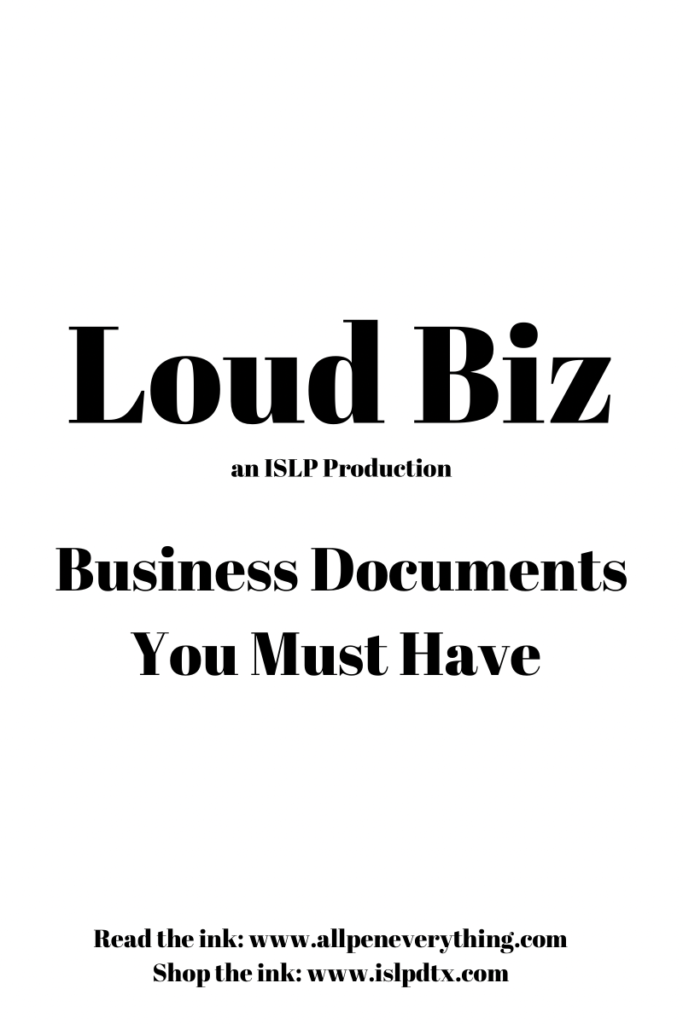Dear Pennies & Pens,
Early last year, I wrote a comprehensive guide on how to start a business. Now, I’m back with more helpful business advice. In this post, Loud Biz: Business Documents You Must Have, I will list which business documents are important to have and why.
As you all know, I am a Creative Entrepreneur + CEO of ISLP, The InkSpot, LLC. Over the years, I’ve applied for many grants, startup competitions, etc. and I’ve noted that they always request various business documents. At first, I would scramble to gather my documents until I finally got organized. These days, whenever I need to access these documents, they are right there ready to go.
So what business documents do you need? Well, it’s actually a mixture of both business and personal documents. What you should do is gather all the documents into one place so that you can access them whenever you need to.
Business Documents You Must Have
- EIN Number – Once you get your EIN number, you will receive a letter with your EIN number & business info. You can either download or receive a copy of the letter via mail. Save this letter in a physical folder (if you have a printed copy) or a digital folder on your computer (if you have a digital copy).
- Certificate of Formation or Incorporation – Once you file your certificate of formation or incorporation aka get your LLC, you’ll receive a letter from the Secretary of State stating that your business is officially registered. Save this letter in a physical folder (if you have a printed copy) or a digital folder on your computer (if you have a digital copy).
- Bank Signature Card – Pennies & Pens, I must admit I had no idea what this was until about a month ago. Basically, a bank signature card is a document that has your business bank account information on it. This document can be used to prove that your business is woman owned or black owned. Please note, the bank creates a signature card when you open your account but the bank will only release it to you upon request. And from there, you must keep track of it because you can’t be issued a new one. To obtain it, visit your bank and show your Driver’s License & debit card so they can verify your identity. From there, the bank will print a copy for you. Save it in a physical folder.
- Form 1040 Schedule C – When you file your business tax returns, you should complete Form 1040 Schedule C. So after completing your taxes, save this document. Grant applications or loan applications often request Form 1040 because it proves that you’ve been filing business taxes. Furthermore, it shows how much revenue you’ve generated from your business. You should file Form 1040 every year and usually grant or loan applications will ask for the most recent year.
- Bank Statements – Grant and loan applications sometimes request recent business bank statements. I know with the PPP loan, they requested these documents. Usually, the most recent bank statements are requested so make sure you have these. Visit your bank’s website and download copies of your bank statements; I would recommend the last 3 months.
- Profit & Loss Statement – A profit and loss statement is an internal document where you outline your business’ revenues and expenses. Basically, you use this document to state how much revenue you made and what your expenses were. It’s a helpful document because it helps you figure out if your business is actually profitable. And that’s exactly why grant and loan applications request it – they want to see if your business is already profitable or has the potential to become profitable before they’ll invest in you. Create this document in Google Sheets or Excel and use your real business numbers. I’ll consider doing a future post on how to create this document.
- Monthly Budget: Overall + Itemized – The best way to create a profit and loss statement is to to have a monthly budget that includes an overall budget and an itemized budget. Start with the itemized budget, including what you spend on business tools & supplies, advertising, production & manufacturing costs, travel, entertainment then sales and income. From the itemized budget, use the total of each section to create your overall budget. This way, you’ll know what you spent on each line item. A budget is important because it helps you see what you’re making and what you’re spending.
- Invoices – If you’re a service provider, you’ll want to save past invoices because they are sometimes requested by grant or loan applications. I would recommend using a service like PayPal to create and send invoices so you can access them easily from multiple devices.
- Driver’s License, Passport, Social Security Card, Birth Certificate – You should also have easy access to these personal documents because they prove your identity which thereby proves that you are the owner of your business. These documents are also requested when applying for certain grants and loans.
- Expense Receipts – On your taxes, you can write off any expenses you spend on the business so save your receipts. I recommend saving receipts according to the expense, example: advertising, travel, entertainment, etc. You can save digital receipts on your computer and physical receipts in a folder. Organize them as you go so filing your taxes won’t be a nightmare.
And there it is. de la Pen…All Pen Everything. With us, keeping it real never goes wrong.
PS Did you know that I offer business development consulting? Click here to learn more.
